NREL Hybrid Platform – New Tool for Utility Scale Optimization and Performance
Aaron Barker and Parangat Bhaskar with host Tim Montague
See the complete interview here
by Ruth Fein Revell – March 15, 2021
Hybrid Power Plants: New Tool for Utility Scale Design and Optimization
With hybrid power plants all the rage, a new tool is available specifically for utility scale hybrid power plant design and optimization, created by NREL (National Research Energy Laboratory).
NREL engineers Aaron Barker, Parangat Bhaskar and team developed HOPP – Hybrid Optimization and Performance Platform – which can be used by developers and others to model solar and storage power plants, or wind and storage, or other generation combinations. “As long as there’s a storage component and a generation component, that’s what we call hybrids,” says Parangat.
First, the two invested time with developers and researchers to compile a list of their pain points. High on the list: transmission constraints (from high solar penetration on the grid) slowing down deployment of future stand alone technology; increased difficulty finding the right piece of land for solar or wind; and small tier developers often losing out to larger players.
When sharing of infrastructure makes sense
There’s increased annual energy production possibilities with complimentary resources, i.e., solar and wind. The wind is blowing at peak at night; the sun shining at peak during the day. “You combine those two resources behind the point of interconnection, and you’re getting a very smooth power output on the other side,” explains Parangat. “Either wind’s going to be blowing or the sun is going to be shining.” You cut down the probability of a system underperforming.
Where does HOPP fit in?
“There are all these kinds of pain points that hybrids are starting to address in the industry, and they have a lot of promise and potential, but with that comes a lot of technical risk and considerations that need to be made,” explains Aaron. “HOPP is a platform for analyzing utility scale plants at the component level.”
HOPP analyzes all the different pieces of the puzzle and looks at how they behave – with different costs, different technical performance parameters, different placement, and in different configurations. “The hybrid industry is still pretty new and there’s no fixed configuration or platform that everyone is going for,” says Aaron. “So people really need a way to analyze the differences between these and see what’s going to work for them and their situation.”
HOPP’s real world value?
HOPP can tell you to put a hundred megawatts of wind, 60 megawatts of solar, and 50 megawatts of storage based on a particular piece of land. Then regarding the interconnection process, what the dollars per kilowatt hour would look like if you were to do solar only, or wind only, compared to a combination. HOPP offers very detailed financial analysis. Once you’ve designed the system, that’s where preliminary engineering and prefeasibility study comes in, according to the team.
When will HOPP be available in the real world?
“It’s available right now,” says Parangat. “It’s on GitHub, it’s publicly available, and there is an open source version of HOPP with almost full features and functionality, just sitting there waiting to be used. We have a bunch of examples that you can run through to build out hybrid plants and play around with everything you might want.”
This complete interview and others can be viewed at the Solar Podcast, and is brought to you by Continental Energy Solutions with host Tim Montague.

Incredibly relevant and useful tool that tackles issues with current available model. Great work!